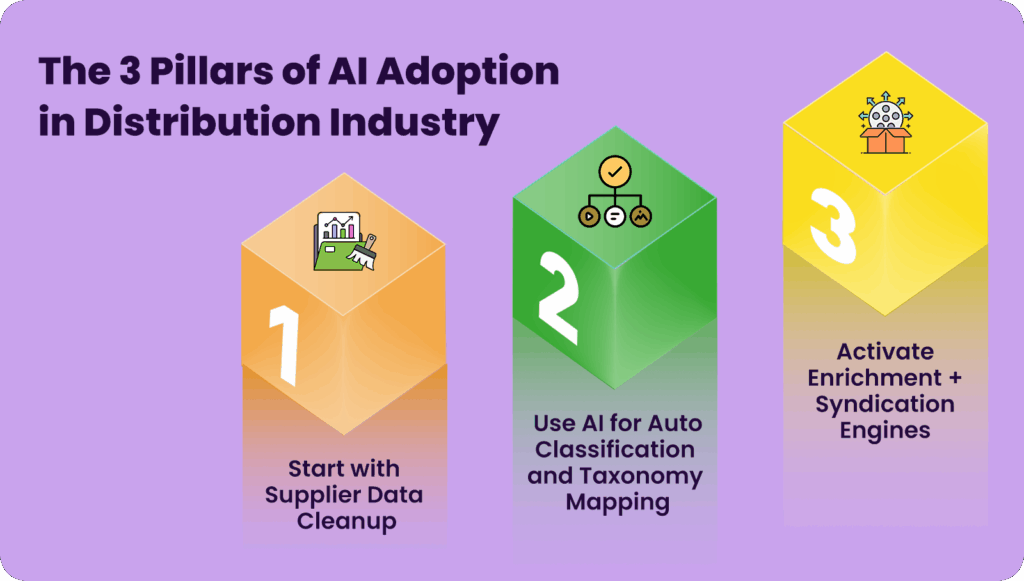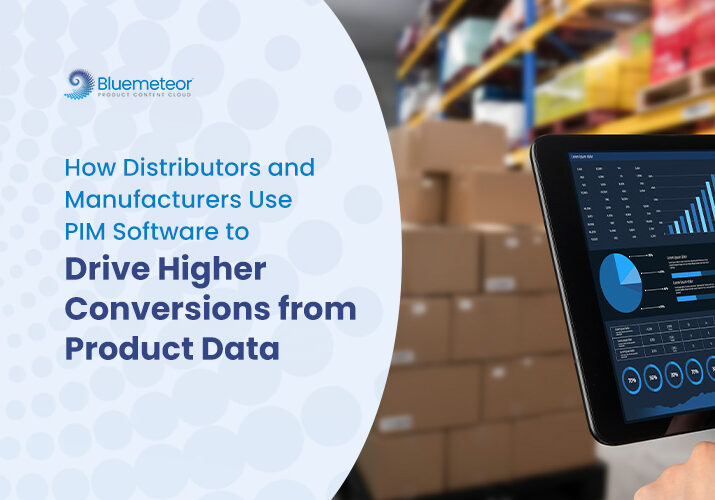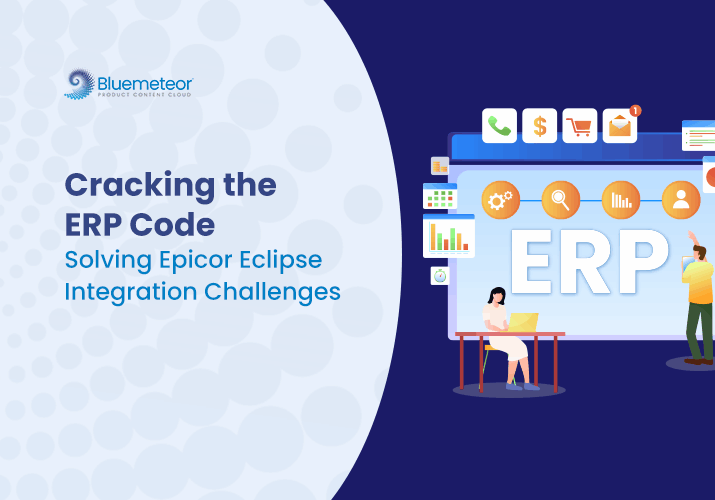Getting Started with Plug-and-Play AI in Distribution: A 2025 Guide | Bluemeteor

AI in the distribution industry is no longer reserved for tech giants. For modern B2B distributors, it’s essential to stay competitive, especially when you manage complex supplier catalogs, onboarding thousands of SKUs, and syndicating data across eCommerce, ERP, and marketplaces.
In this guide, we’ll walk you through how to practically adopt AI across your product content lifecycle, from basic cleanup to advanced enrichment and syndication. Whether you’re a digital lead, product content manager, or IT stakeholder, this is your roadmap to modernizing operations without overhauling your systems.
Why AI in Distribution Industry Is Gaining Momentum (The Industry Reality)
Distribution has always been data-intensive, but the volume, variety, and velocity of product data have exploded in recent years. With thousands of SKUs, dozens of suppliers, and multiple sales channels, manual product data management creates bottlenecks that slow growth and introduce costly errors.
The Pressures Distribution Teams Face:
- Speed to market: New products and SKUs must be onboarded quickly to stay competitive.
- Data accuracy: Mistakes in product specs or missing info can lead to customer dissatisfaction or returns.
- Multi-channel complexity: eCommerce platforms, ERP systems, marketplaces, and partner portals all require different data formats.
- Compliance and standards: Industry-specific standards like ETIM, AHRI, PIE, and PIES/ACES demand strict adherence.
- Resource constraints: Skilled product content teams are often overwhelmed with repetitive data entry and validation tasks.
To address these pain points, AI technologies automate repetitive tasks and introduce advanced data processing capabilities. Moreover, modern AI models, trained on industry-specific taxonomies and large historical datasets, bring both precision and scale.
“According to a recent Bluemeteor client study, distributors implementing AI for product data management reduced manual effort by up to 80%, accelerated onboarding time by 5x, and improved catalog accuracy metrics by over 25%. These are transformative impacts on operational KPIs.”
The 3 Pillars of AI Adoption in Distribution Industry

1. Start with Supplier Data Cleanup (the foundation)
Clean data is non-negotiable. Garbage in, garbage out applies more than ever when you integrate AI with your existing PIM or ERP. AI’s first and most critical job is identifying and fixing data quality issues across supplier catalogs.
- Deduplication: AI algorithms recognize duplicates even if supplier names or SKUs have slight variations. For example, “ABC Industries” and “A.B.C. Ind.” are matched and merged automatically.
- Attribute normalization: When it comes to attribute normalization, AI standardizes product attributes by converting measurements, harmonizing brand names, and unifying formats across the world.
- Error detection: Meanwhile, in error detection, AI identifies anomalies such as missing fields, conflicting specs, or unusual entries that could hinder syndication or procurement.

Therefore, by beginning with supplier data cleanup, downstream AI processes receive reliable input, which in turn enables more effective classification and enrichment.
2. Use AI for Auto-Classification and Taxonomy Mapping
Manually classifying tens of thousands of products across multiple categories and supplier formats is inefficient and inconsistent. However, AI models trained on industry-specific taxonomies (ETIM, AHRI, PIE, etc.) can:
- First, automate classification using natural language processing (NLP) and machine learning to recognize product types from descriptions, specs, and attributes.
- Additionally, they accurately map attributes even when supplier data fields don’t align with your internal schema.
- Moreover, these models continuously learn and improve as more data flows through your system, refining predictions over time.
The impact:
- First, it reduces onboarding time.
- Secondly, it improves search and filtering on your eCommerce platforms, helping customers find products faster.
- Lastly, it enables consistent reporting and analytics by standardizing categories and attributes.
3. Activate Enrichment + Syndication Engines
Once your data is clean and classified, AI-driven enrichment becomes the key multiplier for content quality.
- External data integration: AI automatically pulls missing specs and descriptions from trusted manufacturer databases and reliable public sources, ensuring your product information is accurate and comprehensive.
- Description generation: Using advanced natural language generation (NLG), AI crafts compelling, SEO-optimized product descriptions at scale, enhancing both customer engagement and search visibility.
- Attribute prediction: AI intelligently fills data gaps by inferring likely product attributes based on historical sales patterns, category norms, and similar product profiles, improving completeness and consistency.
- Channel formatting: Content is automatically tailored to the requirements of each sale or distribution channel, whether that’s a B2B marketplace, your ERP, or a partner portal.
This level of automation means you deliver rich, accurate, and compliant product data faster than ever, supporting everything from procurement to marketing.

Addressing Common Concerns: Is AI Truly Seamless and Compatible?
Many distribution leaders initially hesitate to adopt AI because they fear complex IT projects or costly system replacements. But today, the reality has changed. In fact, modern AI solutions integrate seamlessly with existing systems, minimizing disruption and lowering implementation costs.
Importantly, Bluemeteor designs its AI platform to work seamlessly with your existing technology stack.
- Modular deployment: Start small with specific AI features like classification or enrichment, then scale up.
- Plug-in integrations: Works seamlessly with leading ERP, PIM, and DAM systems; no rip-and-replace required.
- User-friendly interface: No coding needed for daily users, with APIs available for developers.
- Industry expertise embedded: Built with industry expertise, the models use real distribution taxonomies and standards to ensure accuracy and relevance.
From Beginner to Advanced: Your AI in Distribution Industry Adoption Roadmap
Here’s a practical framework to grow your AI maturity across product content operations:
| Stage | What it looks like | Next steps to consider |
| Beginner | Manual workflows, basic PIM use | Conduct a supplier data quality audit; pilot AI cleanup tools |
| Intermediate | PIM/DAM platforms in use, some automation | Add AI classification and enrichment modules; train your team on AI insights |
| Advanced | Fully integrated AI-driven Product content cloud | Automate end-to-end content syndication; optimize supplier onboarding workflows |
Remember, AI adoption is a journey, not a sprint. Each stage builds a stronger foundation for smarter data management and better business outcomes.
Embrace AI in Distribution Industry to Stay Competitive
AI-powered product data management is not just a trend; it’s a fundamental shift enabling distributors to:
- Move faster without sacrificing accuracy
- Scale effortlessly across complex supplier networks
- Deliver enriched, standardized product content across every channel
At Bluemeteor Product Content Cloud, we collaborate closely with distributors tired of wasting time cleaning spreadsheets and chasing missing attributes. Therefore, they seek scalable, AI-powered solutions, like our Product Content Cloud, that are specifically built to handle real-world distribution data operations efficiently.
If your team still spends time cleaning spreadsheets or struggles with inconsistent product data, now is the perfect time to embrace AI in distribution. By adopting AI, you enable your team to focus on what truly matters: growing your business.
Ready to see how AI in distribution can work for your business?
You’ve seen how AI in distribution is reshaping how teams manage, clean, and structure product data. The tools are here. The impact is proven. And the good news? You don’t need to build it all from scratch.
Want to see how this can work inside your organization?
Book a personalized demo or strategy call with our team today. We’ll walk you through real use cases tailored to your data challenges.
Related Articles
Recent Post
Categories




